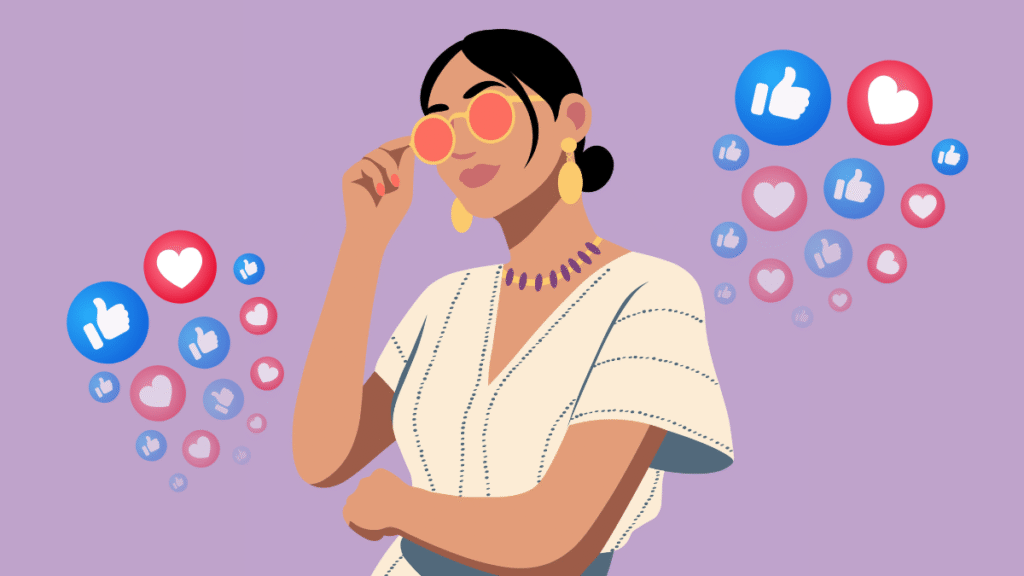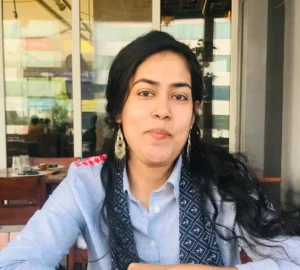By Laraib Fatima Warsi

Feature Image Credit: Illustration by Prayag Aghara, Unsplash
I met my friend after months of being swallowed up by work, family, and the relentless blur of “adulting.” Over coffee, we confessed how tired we were not just physically, but from always being “on.” Trying to look a certain way, aiming for aesthetic photos, chasing attention, and worse – validation. Perfect lighting, flawless skin, the Instagrammable pose…it’s exhausting. She asked me: Am I presenting myself, or someone else’s idea of me?
That question has haunted me. Because the empowerment narratives speckled all over social media are bright and promising, but they sometimes feel like new kinds of submission. Not freedom. Not autonomy. Rather, compliance with capitalism, popularity, and conservative beauty ideals. Even sitting alone with a coffee, I wonder: do I see myself, or the version Instagram rewards?
Because so much of what’s sold as empowerment online is less about liberation and more like a curated costume. One that demands constant perfection: glowing skin, trending clothes and expensive routines. What lies beneath is often messy – self‑doubt, insecurity, but glossed over, because we are too busy chasing trends, likes, and visuals.
Young women in smaller towns absorb this especially. It’s as if their worth depends on how photogenic they are, how well they perform, and how pleasing they look to everyone watching.
Take content creator and actor Kusha Kapila, for instance. She once opened up that throughout her weight‑loss journey, she felt “someone else was talking about my body more than me.” She said that multiple “transformation reels” of her made her feel like she wasn’t even in her own body. Her journey began with acne, PCOD, and issues with body image, not simply with wanting to appear beautiful. And yet so much of social commentary focused only on the “after”: how she looked, what she became.
Her story is not unique. So many tie their hopes, their self‑worth, to compliments, attention, to validation from strangers or distant followers, forgetting the girl who existed before the filters. Beauty brands, fashion labels, cafes, creators; they profit from these insecurities. They sell the idea that to be valued, you must become someone else’s ideal.
But perhaps we don’t have to play their game. We don’t have to become content creators by default. We don’t have to shrink ourselves into one fixed identity just to feel like we belong. We don’t have to shrink into fixed identities just to feel we belong. We can say no to aesthetic pressure, performative perfectionism, and curated selves. We can choose what feels true, even when it’s messy. We – especially young women in small towns – deserve freedom rooted in ourselves.
Influencers are both mirrors and moulds: their images reflect what’s admired, and also shape what becomes admirable.
Komal Pandey, a fashion influencer many admire, has been open about pressure to tweak her appearance: she has admitted to getting lip and chin fillers, and briefly trying Botox. When people accuse her of editing her photos or chasing followers, she doesn’t just object on vanity grounds; she speaks of years of discomfort with her body image, of trying to live up to ideals she felt she didn’t already embody.
The rewards are clear: brand deals, visibility, financial gain, and identity reinforcement through curated aesthetics. Yet the cost is rarely visible. Especially for young women without those resources from towns outside big metros – the stakes can be higher. To imitate the glamorous filtered lives of creators, you may need money, access, and social networks. Meanwhile, trying to keep up can drain mental health, self‑esteem, and a sense of authenticity.
Young women in smaller towns and cities are often drawn into influencer culture: adopting influencer trends, seeking validation through likes and comments, and constantly busy creating curated personas to meet ever‑shifting expectations. That pressure can take a real toll on mental health and the sense of what’s genuine. They chase status symbols, designer items, beauty standards, Instagram‑worthy aesthetics – only to feel that their true selves are slipping away. The result is a cycle of comparison, body image issues, and self‑doubt when what they see online becomes the benchmark for their value.
Anam Faheem, a 24-year-old mass communication student from Lucknow, follows creators like Kusha Kapila and Komal Pandey and sees beauty in how their feeds are styled. “I want my photos to look like theirs,” she told me. “Good lighting, perfect skin, captions that sound inspiring.” She reposts looks she can’t truly afford, visits cafés not for the food but for the background, buys skincare with promises she hopes will deliver. It’s not always about passion; it’s about being seen.
But these aesthetic trends have spread far beyond metro cities, and for young women like Anam, they risk erasing one’s own self or personality.
Many are following influencers blindly- buying overpriced clothes or bags, visiting high‑end cafes with friends just to get shareable photos, mimicking captions, poses, and styles. These efforts don’t just hurt their wallets; they weigh heavily on identity. Instead of growing into their own voice, many end up becoming copies.
Another young woman I spoke with is Divya Singh, a 23-year-old Fashion and Design student in Agra. She echoes similar feelings. “I try to copy their aesthetic to buy the same clothes, and use similar poses. Someday I want people to see me like I see them.” But in doing so, she wonders: which parts of her and what she once liked – am I leaving behind?
This pursuit of validation, likes, shares, and follows becomes addictive. There are nights staring at post notifications, refreshing pages. Those small cities may not offer the same access or cultural permission as metros, yet the aspiration spreads; the invisible metric becomes: how well do I measure up to the ideal?
The Tension Between Visibility and Autonomy
Creators sometimes confess their struggles – acne, cosmetic interventions, or anxiety over body image but usually after the polished images have circulated. Authentic moments are often reactive: responses to criticism, or moments when something fails. But the polished image comes first.
Adrienne Rich, in the 1972 essay When We Dead Awaken: Writing as Re‑Vision, argues women must revise not only how they see themselves but how they are seen by others. Break free from the male gaze, tradition, and imposed identity. See with fresh eyes. Name oneself. These are not easy actions.
Real autonomy: not defined by how many see you, but by whether you know yourself. True freedom: not a flawless grid, but becoming. Imperfect. Honest. Your own.
What if empowerment wasn’t another filter? What if, instead of performing for algorithms, we perform for ourselves or not at all? What if we logged off, said no to certain posts, refused to become content just because Instagram tells us what “good” looks like?
Maybe we could build small rituals of self-acknowledgement: writing, drawing, cooking, being quiet with our bodies, in clothes we’ve chosen because they feel good, not because they look good on a feed. Maybe we could learn to pleasure ourselves in unfiltered textures, pimples, frizzy hair and laughter with friends when the lighting is bad.
Because when we stop measuring value by how well we fit into an Instagram ideal, maybe we find ourselves again not in highlight reels, but in messy mornings, in unfiltered moments.
The pressure of perfection is real. But freedom is possible. It looks less glamorous than influencers’ feeds, less liked, less shared. It doesn’t always photograph well. But it can be real. And rooted in self.
As Bell Hooks said, “The function of art is to do more than tell it like it is – it’s to imagine what is possible.” Real empowerment lives in that imagination, not imitation.
Laraib Fatima Warsi is an independent journalist based in Lucknow, focusing on culture, identity, and social change. She combines reportage and narrative storytelling to illuminate stories of place, tradition, and the digital age.

Subscribe to our newsletter To Recieve Updates
Join our newsletter to receive updates